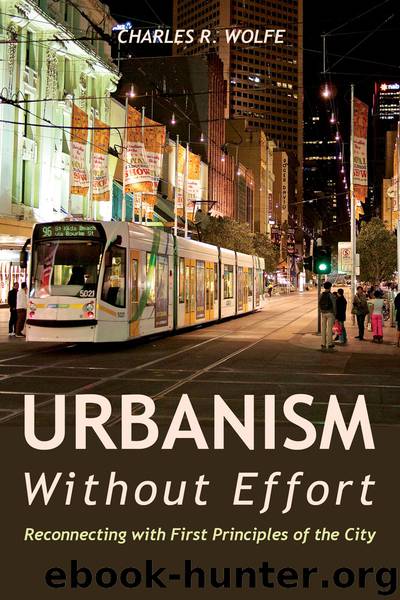Urbanism Without Effort by Charles R. Wolfe

Author:Charles R. Wolfe
Language: eng
Format: epub
Publisher: Island Press
Published: 2019-03-09T16:00:00+00:00
Figure 3–3: Barcelona: Plaça de Catalunya “occupied.”
Figure 3–4: Barcelona: the Ramblas style.
Figure 3–5: Rome: the quintessential urban space, Campo de’ Fiori.
My own, filmed walks through Campo de’ Fiori and nearby Piazza Navona at night display the magical confluence of place, commerce, human social activity, conducive climate, and sense of safety.7 The historic story of the place itself suggests that the context in which a place evolves is key to the actual physical experience and its related urban character. Do we do injustice to a rich history of place by assuming we can re-create the physical form inherent in the “backstory” of a specific place? For example, a former field, once the location of gallows for minor offenses; a juncture of streets surprisingly devoted to trades; a market by day then later a haven of nightlife. Can a newly created place be just as rich in experience without its own backstory?
Some years ago, while on sabbatical from my former law firm, I presented a talk asking Cornell University students who were studying in Rome to reflect on the context of what they had learned while studying abroad. A summary of the handout appears as follows, which contains a proposition that could very well have originated from a client requesting legal assistance through my law practice.
Rome contains some of the world’s most successful “public spaces.” Assume you are an American planning director who receives a request from a city council member who has just returned from a trip to Rome. The council member wants to pressure local mall redevelopers to create a space reminiscent of Campo de’ Fiori at the center of a 1960’s era shopping mall which is subject to pending development approvals for a multi-million-dollar renovation. What features can you insert in the development agreement draft to attempt such ambiance? Can successful public spaces be successfully legislated?
The issue of context dominated the questions asked in the handout. Similarly, context is key to the dilemma of imposing patterns from another history on an urban setting derived from a different cultural tradition. As with the passeggiata, this dilemma may yield more questions than certainty in changing times.
Certainly, such spaces are ripe for first-person observation and inspiration. But should professionals indiscriminately design and program local spaces that only mimic the authentic or original spaces? Should every city have a “High Line” or other reuse of abandoned or now-dysfunctional infrastructure such as an unused ramp or tunnel? Is replication possible without resulting in Huxtable’s Disney-fication, or is it even wise?
Perhaps the answer lies in the scale of the endeavor and my oft-repeated distinction between inspiration and prescriptive replication. Assuming such an idea is well vetted and public input is under way, review of the linked videos mentioned earlier could be used as an “idea management” step to assess the adaptability of an active Campo de’ Fiori–type space. I have written about such idea management before, from the standpoint of a practitioner, anchored on the “how” to implement new approaches in cities, and I have
Download
This site does not store any files on its server. We only index and link to content provided by other sites. Please contact the content providers to delete copyright contents if any and email us, we'll remove relevant links or contents immediately.
The Secret History by Donna Tartt(16622)
The Social Justice Warrior Handbook by Lisa De Pasquale(11489)
Thirteen Reasons Why by Jay Asher(7788)
This Is How You Lose Her by Junot Diaz(5771)
Weapons of Math Destruction by Cathy O'Neil(5036)
Zero to One by Peter Thiel(4824)
The Myth of the Strong Leader by Archie Brown(4789)
Promise Me, Dad by Joe Biden(4447)
Beartown by Fredrik Backman(4415)
Stone's Rules by Roger Stone(4415)
How Democracies Die by Steven Levitsky & Daniel Ziblatt(4398)
The Fire Next Time by James Baldwin(4342)
100 Deadly Skills by Clint Emerson(4076)
A Higher Loyalty: Truth, Lies, and Leadership by James Comey(4032)
Rise and Kill First by Ronen Bergman(4012)
The David Icke Guide to the Global Conspiracy (and how to end it) by David Icke(3881)
The Farm by Tom Rob Smith(3872)
Secrecy World by Jake Bernstein(3782)
The Doomsday Machine by Daniel Ellsberg(3730)
